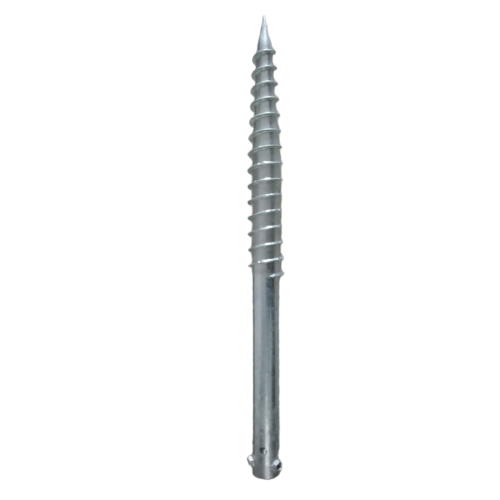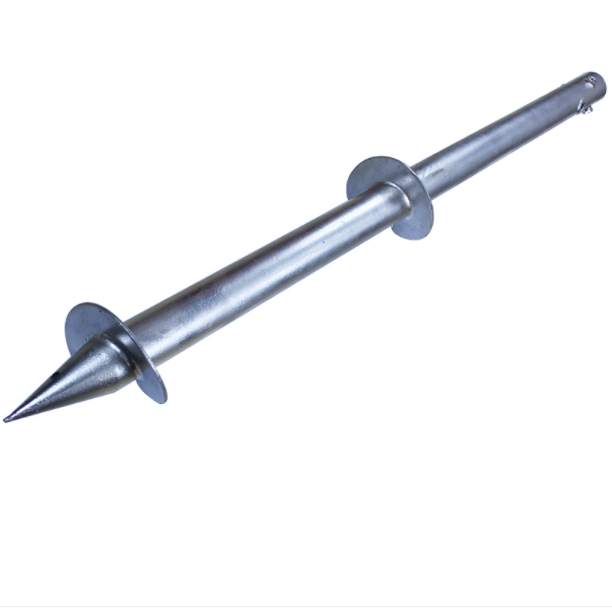The United States is a vast landmass. With varying altitudes, water tables and environments, the soils between our two ocean coasts can be sandy, soft, rocky or clay-laden. Solar installers have to navigate many unique soil requirements when working on ground-mount projects.
The five most common solar ground mounting solutions — I-beams, helical anchors, ground screws, concrete piers and ballast — have specific homes across the country. It really depends on what’s going on in the soil underneath your feet. Galvanized Ground Anchors

APA Titan racking with I-beam mounts.
I-beams are a common component across the field of construction, used as structural supports in horizontal and vertical applications in buildings. They are also the most common ground-mount option for solar systems.
I-beams, H-beams or C-channels are installed using a piledriver that pushes them directly into the earth. Racking is then attached to the exposed beam. Beams can be mounted in clay, black and sandy soils, and work best when the site is rock-free. The soil’s friction keeps the piles in place.
For I-beams in sandy soil, embedment depth is based on grain size. Higher water tables can reduce friction and require a pile to be driven deeper than usual.
“It can work in any soil condition, and it just depends on mechanical properties of that soil for the friction of how deep that pile has to go,” said Josh Von Deylen, CEO of APA Solar Racking. Pile testing is required to determine the correct depth, a process that can be expensive. Installers make up that money by installing more beams, which is why a pile-based solar installation doesn’t make sense on small projects.
I-beams come with a higher price tag than some smaller post mounts, but are ideal for larger-scale systems, Von Deylen said, because they have stronger load bearing and require fewer penetrations per rack compared to helical anchors or ground screws.
Helical piles are cylindrical posts with, as the name suggests, a helix that’s two or more inches wide, mounted or attached near the bottom of the post. Once driven the proper depth, the helix portion of the anchor will resist being pulled out by creating a cone of soil above it. Helical piles are installed by digging an initial guiding hole and using a skid steer with a rotating attachment to spin the mount into place. APA Solar Racking carries a helical anchor with replaceable helixes in various lengths to adapt to different ground conditions.
With a smaller surface area, helical piles will embed with minimal soil disturbance. The design of helical piles makes them ideal for sandy, black or clay soils, as well as areas with high water tables, where piles require greater depths for embedment. Helical piles will embed at shorter depths in soft and sandy soils compared to I-beams.
“Other foundations could not work, but the helical with the flanges works perfectly for those…because a driven pile is going to have very different characteristics on almost every site vs. a helical [that] almost has identical characteristics on every site,” Von Deylen said.
Ground screws work similarly to helical piles, also creating a cone of soil that resists upward tension. The ground screw’s difference in design lies in its threaded end that leads to a point, much like in carpenter screws. Turnkey solar-racking company TerraSmart fabricates and installs ground screws of varying sizes to adapt to different soil types.
To install a ground screw in dense soils, contractors core a pilot hole, set the screw inside and drive the mount into the ground using a rotary hydraulic drive or proprietary machinery. In medium-dense to loose soils, ground screws can be driven directly into the ground.
These mounts were built to work in rocky landscapes. The pointed, threaded end is outfitted with a forged chisel-tip that is able to push smaller rocks aside, and installers can even drill a starting hole into larger stones to rotate the ground screw directly into the ledge.
“Ground screws work in a wide range of soils and it comes down to how you design the ground screw to accommodate where you’re trying to install into,” said Richard Van Fleet, director project operations at TerraSmart. “On a looser site, you might have a longer or wider ground screw vs. a rocky site. We can accommodate those different soil conditions with the design of the ground screw itself.”
This mounting solution has a smaller post surface area similar to helical piles but comes in longer post lengths to ensure proper embedment depth. A set of racking can attach to ground screws of various lengths, keeping panels level while adjusting to varying topography.
Ballasted systems are a non-penetrating foundation solution for solar. Racking is attached directly to a footing, block or basket, and concrete is commonly used as the weight to hold it in place. The concrete is either precast, in which posted are mounted to blocks brought to the site; or concrete is poured into basins and cured on-site around the posts.
Deciding which concrete solution to use depends on site conditions, job costs and system size. Ballasted systems are often used on volatile sites, like landfills, brownfields and Superfunds, where the soil cannot be penetrated due to potential contamination.
The cast-in-place concrete solution is ideal for projects with low labor costs and easy access for heavy equipment. The site should be able to handle the weight of a concrete truck and requires handling concrete-pouring hoses. The precast route is suited for projects near distributors that can deliver the concrete blocks. With their modular design, they’re easy to deliver. Installers can take blocks off the trailer and set them on their designated position before attaching the racking systems.
“We don’t have to worry about curing the concrete on-site, so you don’t have potential weather delays, and you can get a lot of work done off the site before it’s even ready to be started,” said Mike Freshwater, ground mount operations manager for RBI Solar.
Using concrete foundations above the ground means panels can be disconnected and racking can be moved around, in cases like landfills, where routine inspections need to take place. RBI Solar carries preassembled fixed-tilt racking designed to work with both precast and cast-in-place concrete ballasts.
A tip for using heavy equipment on volatile job sites is to opt for machinery that uses tracks instead of tires. A tracked machine’s weight is distributed across the ground surface more evenly than those on wheels, Freshwater said, and will alleviate ground pressure on sensitive sites.
There is another mounting method that uses concrete but requires significantly more excavation than narrower, pile-driven foundations: concrete piers. These posts are suspended in holes 12 to 18 in. in diameter, with a depth of 6 to 8 ft., and wet concrete is poured around them.
Concrete piers are suited for smaller projects, sites with corrosive or swampy soils and installations in regions prone to hurricanes and high winds. They tend to be more expensive than the smaller drilled or driven mounts.
“We typically do those in areas where you’re at 30, 40% slope, where you can’t get standard construction equipment on the site or you’re just limited to what construction equipment you can use,” Freshwater said. “At other times, when we’re doing projects where you’re very much prone to hurricanes, our customers tend to want to be very precautious and go with a more robust foundation.”
Concrete piers are often the only option in high pH soils where the corrosive soil will damage metal posts. A high-psi concrete pier will not break down as quickly.
“The things you want to look out for in addition to acidity or the pH is your sulfides in the soil, your chlorides, your soil resistivity and your moisture content,” Freshwater said. “So, if you have very high-corrosive soils, concrete is an option to help get you the lifespan of the system that you desire.”
Whether the soil is sandy, rocky, loose, dense or corrosive, there’s a marketplace of solar mounting products that are designed to fit an installer’s needs on most worksites.
Billy Ludt is senior editor of Solar Power World and currently covers topics on mounting, installation and business issues.
whats your solution for soil with ledge down around 4-5 ft perferabbly the cheapest
What do you suppose the minimum useable N-value (blowcount) would be for helical piers in this application? We have a site that has very soft clay soils (N=3) to a significant depth and are trying to avoid deep (e.g. on the order of 20+ feet) tip elevations for the installed foundation elements.

Spiral Ground Piles For Photovoltaic Bracket Copyright © 2024 WTWH Media LLC. All Rights Reserved. The material on this site may not be reproduced, distributed, transmitted, cached or otherwise used, except with the prior written permission of WTWH Media Privacy Policy | RSS